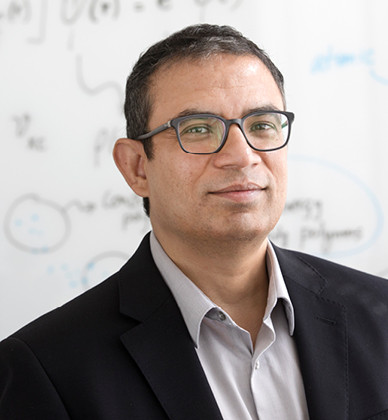Rampi Ramprasad, Ph.D.
Energy Sustainability
Georgia Institute of Technology
Recruited: 2017
Rampi Ramprasad is designing new materials to improve energy storage and support the technology of today and tomorrow. At the same time, he’s creating computer modeling systems that make that design process faster, cheaper and easier, for himself and for other materials scientists.
Ramprasad is at the forefront of a movement that uses computer systems to conduct virtual screenings of potential new materials, guiding and accelerating the slow and costly process of building and testing materials in the lab.
His sophisticated computer models use quantum mechanics to predict the characteristics of hypothetical new materials. Using computation, Ramprasad can evaluate hundreds of potential materials, pick those that show the greatest promise, and have only those few best candidates produced in a lab for testing.
In addition, Ramprasad uses artificial intelligence techniques to make computer modeling exponentially more effective, essentially “teaching” the computer to make predictions about new materials. Such predictive computing is called machine learning, and it saves even more time by allowing the computer to rely on past data – whether from previously built computer models, or from lab testing of actual materials – to build new models, rather than starting from scratch.
In an effort to support scientific progress throughout the field, Ramprasad shares his tools and his data with the materials science community via his data and software portal. One tool available there is the Polymer Genome, which can provide instantaneous predictions about polymers – both those that have previously been tested in the lab, and those that are in the hypothetical idea stage.
Using Polymer Genome is as simple as selecting chemical elements and “drawing” a polymer with those elements as building blocks. The tool relies on its stored data to predict what this new polymer’s properties would be – for example, its density and capacity to store energy – based on its similarities to previously tested polymers. This basic information comes back in a matter of seconds and gives a materials scientist a good sense of which ideas are worth exploring further.
Polymer Genome was built as part of research Ramprasad did while at the University of Connecticut through a Multidisciplinary University Research Initiative (MURI) grant. Sponsored by the U.S. Office of Naval Research, the MURI research set out to develop better polymers for use in capacitors for energy storage.
A capacitor is useful for any situation that calls for quick energy capture. For example, in an electric car, some of the energy created by braking can be recovered and sent back to the battery, in a process known as regenerative braking. However, the car battery can’t absorb this quick burst of energy all at once. The capacitor serves as a reservoir that holds the energy and then releases it slowly to the battery.
The polymer within a capacitor, called a dielectric, is an insulator that becomes polarized when it’s in an electric field. This allows the capacitor to store more energy. In the MURI research, Ramprasad and his colleagues formulated several highly promising dielectric candidates, which have since been produced in the lab, tested and validated.
Based on the success of that MURI research, the Office of Naval Research selected Ramprasad to lead a second, $7.5-million MURI grant, to study how polymers break down when they are exposed to strong electric fields. When they break down, they no longer perform as insulators, but are transformed into conductors that let electrical current pass through. Studying how the materials fail will give Ramprasad and his colleagues knowledge that can lead to the development of hardier polymers for use in electrical settings.
In addition, Ramprasad is part of a research effort funded by the Toyota Research Institute to help create a polymer-based battery. Today’s electric and hybrid cars use lithium ion batteries that contain a liquid electrolyte. The batteries perform well, but the liquid inside them is heavy and can leak, whereas a polymer-based battery would be lighter and safer.
This poses a difficult challenge, because the polymer will have to allow ions to pass through it – and that isn’t something known polymers can do as well as liquid electrolytes.
To meet Toyota’s goal, Ramprasad will not only be looking for a novel polymer but will be developing new computing and artificial intelligence-based tools that can help him solve the puzzle.
In the future, Ramprasad hopes to create tools that not only predict the properties of a new material, but also determine the best way to synthesize the material – while ruling out those that look good in computer models but which can’t practically be made. He also hopes to increase the role of artificial intelligence in materials design, developing computer programs that can guide the earlier phases of the discovery process.
Research
- Polymer informatics
- Machine learning force fields
- Dielectric aging and breakdown
- Machine learning density functional theory
- Polymer battery electrolytes
Straight from the Scholar
“The data science effort at Georgia Tech is extremely strong, and there is also a very strong desire here to bring data science into materials science and chemical science. Being a GRA Eminent Scholar made moving to Georgia very attractive for me, because GRA immediately puts me in touch with so many things that I would not normally have. GRA gives me contact with the other Eminent Scholars, opportunity for collaboration with them and other platforms such as entrepreneurship through GRA’s venture development program.”
Intellectual Property
4 patents

